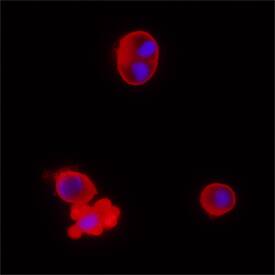Human Caspase-2 Antibody
R&D Systems, part of Bio-Techne | Catalog # MAB7228

Key Product Details
Validated by
Species Reactivity
Applications
Label
Antibody Source
Product Specifications
Immunogen
Gly170-Asp333 & Ala348-Tyr452
Accession # P42575
Specificity
Clonality
Host
Isotype
Scientific Data Images for Human Caspase-2 Antibody
Caspase‑2 in Jurkat Human Cell Line.
Caspase-2 was detected in immersion fixed Jurkat human acute T cell leukemia cell line treated with with staurosporin using Mouse Anti-Human Caspase-2 Monoclonal Antibody (Catalog # MAB7228) at 25 µg/mL for 3 hours at room temperature. Cells were stained using the NorthernLights™ 557-conjugated Anti-Mouse IgG Secondary Antibody (red; Catalog # NL007) and counterstained with DAPI (blue). Specific staining was localized to cytoplasm. View our protocol for Fluorescent ICC Staining of Non-adherent Cells.Applications for Human Caspase-2 Antibody
Immunocytochemistry
Sample: Immersion fixed Jurkat human acute T cell leukemia cell line treated with with staurosporin
Formulation, Preparation, and Storage
Purification
Reconstitution
Formulation
Shipping
Stability & Storage
- 12 months from date of receipt, -20 to -70 °C as supplied.
- 1 month, 2 to 8 °C under sterile conditions after reconstitution.
- 6 months, -20 to -70 °C under sterile conditions after reconstitution.
Background: Caspase-2
Caspase-2 (Cysteine-aspartic acid protease 2/Casp2; also NEDD2 and ICH-1) is a 30‑32 kDa member of the peptidase C14A/IL-1 beta-converting family of enzymes (1‑3). It is widely expressed and is an integral component of the apoptotic cascade. Based on the length of its prodomain, caspase-2 has been considered to be an initiator caspase. However, studies have shown that other caspases (such as Casp 3) activate procaspase 2, and Caspase-2 likely acts on key cellular molecules such as BID, Golgin 160 and DFF45/ICAD (2, 4, 5). Thus, Caspase-2 is perhaps more likely to be a specialized executioner caspase. Human procaspase-2 is a 48‑51 kDa, 452 amino acid (aa) protein (4‑7). It is known to exist as a disulfide-linked homodimer via covalent linkage at Cys436 (2, 5). But this dimeric state may not be sufficient for (auto)activation. Actual activation may occur following oligomerization within the context of activating platforms such as DISC (death-inducing signaling complex) or the PIDDosome (8-10). Initially, procaspase-2 undergoes proteolytic cleavage to generate an N‑terminal 333 aa p34/34 kDa subunit, and a 119 aa C‑terminal p14/14 kDa subunit (5). The p34 and p14 subunits are further processed to generate the prodomain (aa 1-169), plus the mature p18 (aa 170-333) and p12 (aa 348-452) subunits (4-6). Notably, each p18:p12 noncovalent heterodimer demonstrates proteolytic activity around a catalytic site at aa 318-322, and, due to an nuclear localization signal within the prodomain, may be found in either nucleus or cytoplasm (11, 12). There are multiple potential isoform variants. Individually, or in combination, there is an alternative start site at Met18, a substitution of two aa for aa 107-452, a second substitution of 14 aa for aa 309-322, and a third substitution of 22 aa for aa 323-452 (6, 7, 13). The human and mouse procaspase 2 precursors are 90% aa identical, with the majority of differences lying in the prodomain.
References
- Chowdhury, I. et al. (2008) Comp. Biochem. Physiol. B 151:10.
- Krumschnabel, G. et al. (2009) Cell Death Differ.16:195.
- Kitevska, T. et al. (2009) Apoptosis 14:829.
- Paroni, G. et al. (2001) J. Biol. Chem. 276:21907.
- Li, H. et al. (1997) J. Biol. Chem. 272:21010.
- SwissProt. Accession # P42575.
- Wang, L. et al. (1994) Cell 78:739.
- Chang, D.W. et al. (2003) J. Biol. Chem. 278:16466.
- Olsson, M. et al. (2009) Oncogene 28:1949.
- Tinel, A. & J. Tschopp (2004) Science 304:843.
- Schweizer, A. et al. (2003) J. Biol. Chem. 278:42441.
- Colussi, P.A. et al. (1998) J. Biol. Chem. 273:24535.
- Droin, N. et al. (2000) Cancer Res. 60:7039.
Alternate Names
Gene Symbol
UniProt
Additional Caspase-2 Products
Product Documents for Human Caspase-2 Antibody
Product Specific Notices for Human Caspase-2 Antibody
For research use only
